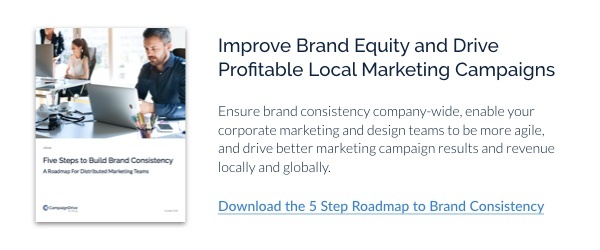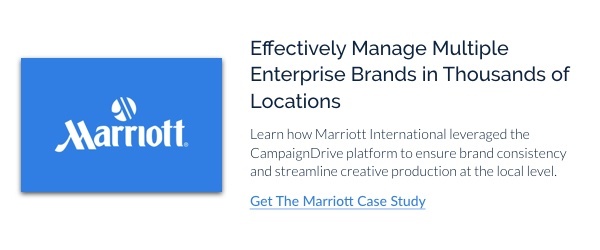Brand compliance refers to the way that messaging conveys a brand’s core values, standards, and visuals to the audience in a consistent and dependable manner. Assets that are brand-compliant will reflect the brand in language and tone, character, graphics and images, font and logo.
A consistent presentation of brand-compliant assets helps to relay reliability and expectations to consumers. When customer expectations are met and reinforced through brand consistency, positive brand equity is also generated, further strengthening the brand.
A failure in brand compliance can have the opposite effect, breaking down the relationship between consumer and brand. Inconsistent marketing assets make it difficult to validate the message of the brand, making it seem less credible in the eyes of the audience.
Not Utilizing Brand-Compliant Marketing Assets Negatively Impacts:
1. Customer Base and Revenues
A 2016 report¹, “Impact of Brand Consistency,” found that organizations that made an effort to maintain brand consistency attribute 10 percent or more growth to those efforts – and one in five credit 20 percent of growth to brand consistency. The average revenue increase attributed to brand consistency is an estimated 23 percent.
Brands that do not make an effort to present a consistent message to customers through brand-compliant assets may lose the opportunity to grow their customer base and suffer a loss of revenue directly as a result of brand inconsistencies.
2. Brand Awareness
Consumer awareness of a brand is anchored in the experience of connecting with that brand. A consistent identity gives the audience a fixed point of reference for that experience, which is reinforced with every new message that is consistent with the brand which increases the audience’s awareness of that brand.
Using non-compliant brand assets represent not only a lost opportunity to connect and reinforce brand messaging, but also diminishes established connections between the consumer and brand, degrading brand awareness.
3. Consumer Trust
According to research from Accenture², lack of trust costs global brands $2.5 trillion per year and $756 billion lost by companies in the U.S. alone.
Customer trust is built through every type of contact between customer and brand. Regardless of the type of contact, or the channel used, messaging must be consistent and reliable in order to generate and improve consumer trust and confidence in a brand.
Branding is the heart and soul of a company, the most important intangible assets that an organization has to offer. It incorporates company values, mission, perceived quality, and reputation into a recognizable entity for customers.
Brand-compliant marketing efforts are key to building a relationship with audiences by presenting and reinforcing dependable messaging, language, tone, and ideas. That’s why brand-compliant assets are so important to improve the perception of a brand integrity and reliability. Likewise, using non-compliant brand assets creates a negative perception of deceit, fraud, or dishonesty.
However, brand compliance can be difficult to achieve, particularly across franchisees and local affiliates. Corporate brand managers and designers may be inundated with requests from affiliates, resulting in slow workflows and a lack of assets available to distributed networks.
Say Goodbye to Inconsistent Branding with CampaignDrive by Pica9
A brand compliance system can be extremely effective in ensuring that local brand assets are consistent and on target. A centralized database to store, collaboration, and distribute all brand-compliant assets give managers of the brand better administrative controls and standardization. Distributed networks of employees can also easily gain access to approved content to create effective local marketing campaigns.
CampaignDrive is a distributed marketing platform that promotes brand compliance throughout enterprise and franchise businesses. Brand managers are given the administrative tools they need to manage and secure brand-compliant assets across local marketing teams for brand consistency and faster production time.
To see how the CampaignDrive platform tools can strengthen your brand, request a demo today!
Sources:
-
https://d2slcw3kip6qmk.cloudfront.net/marketing/press/webinar/The-Impact-of-Brand-Consistency-Report-New_Cover.pdf
-
https://socialmediaweek.org/blog/2018/02/lack-trust-costs-brands-2-5-trillion-per-year-study/






